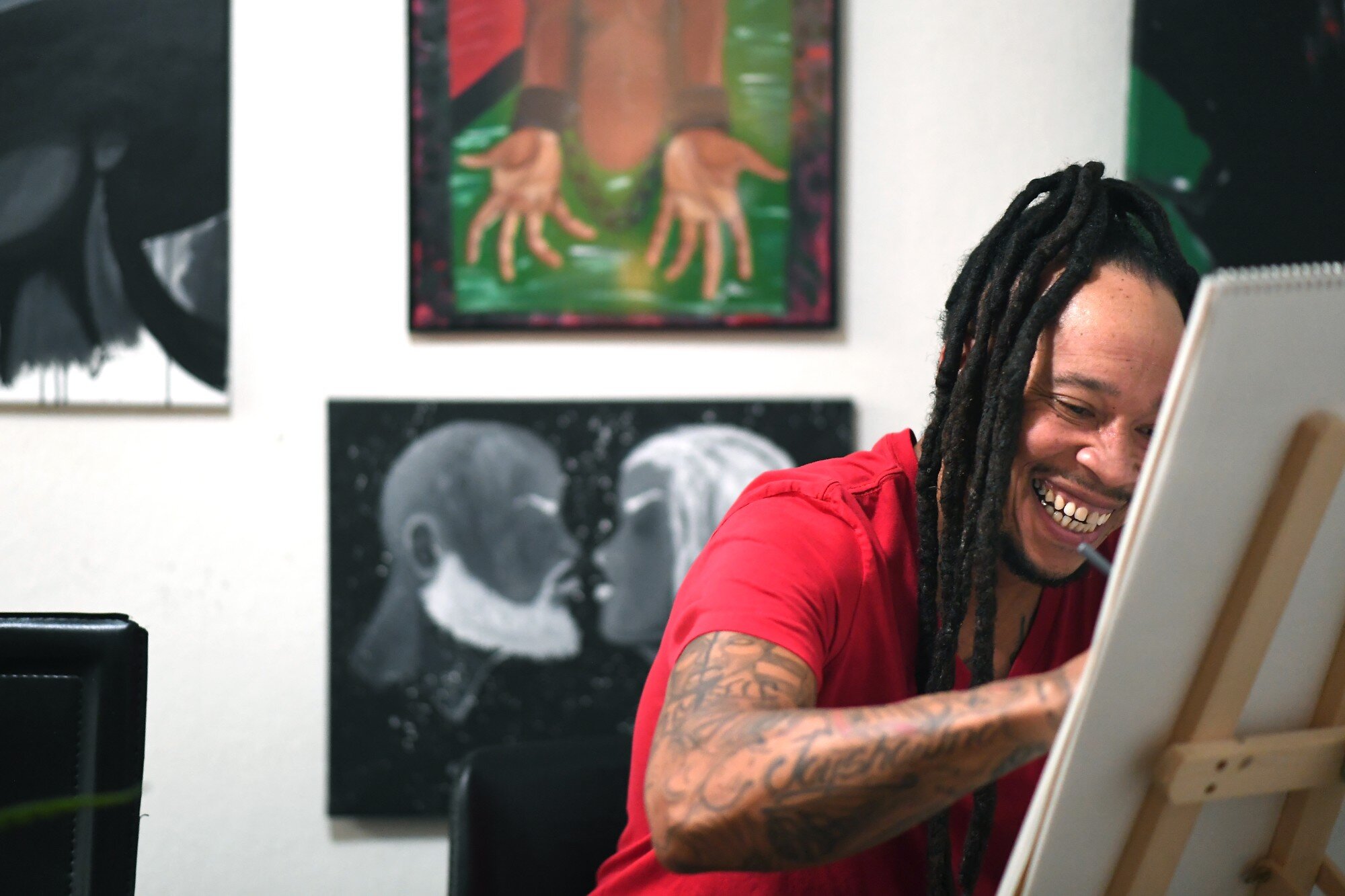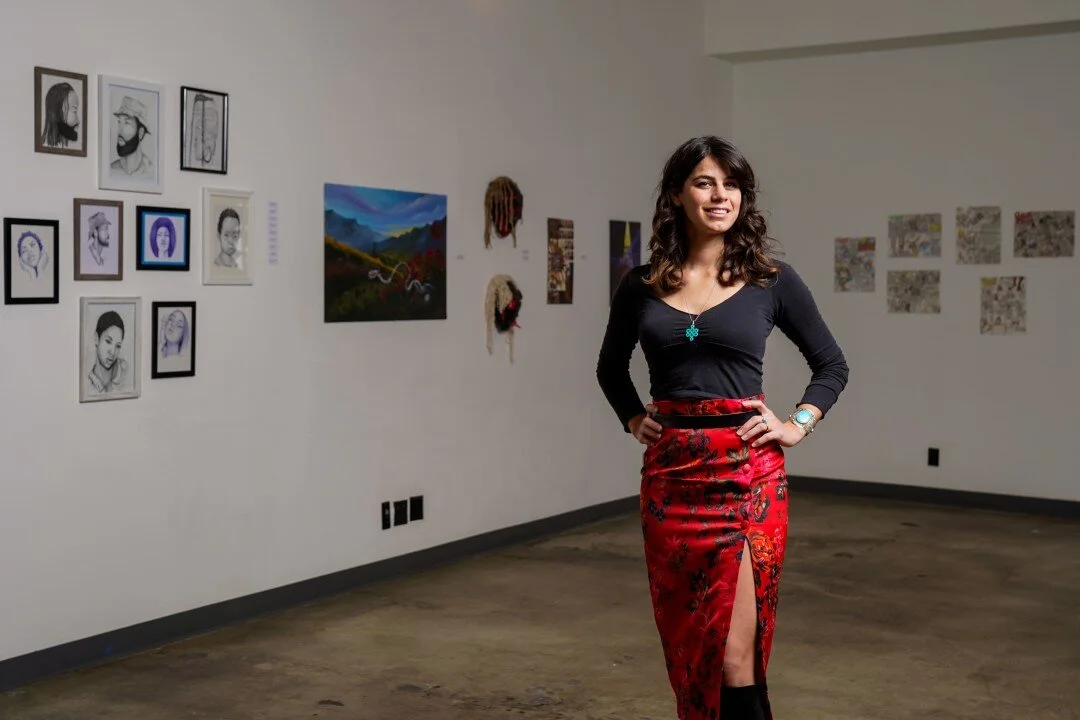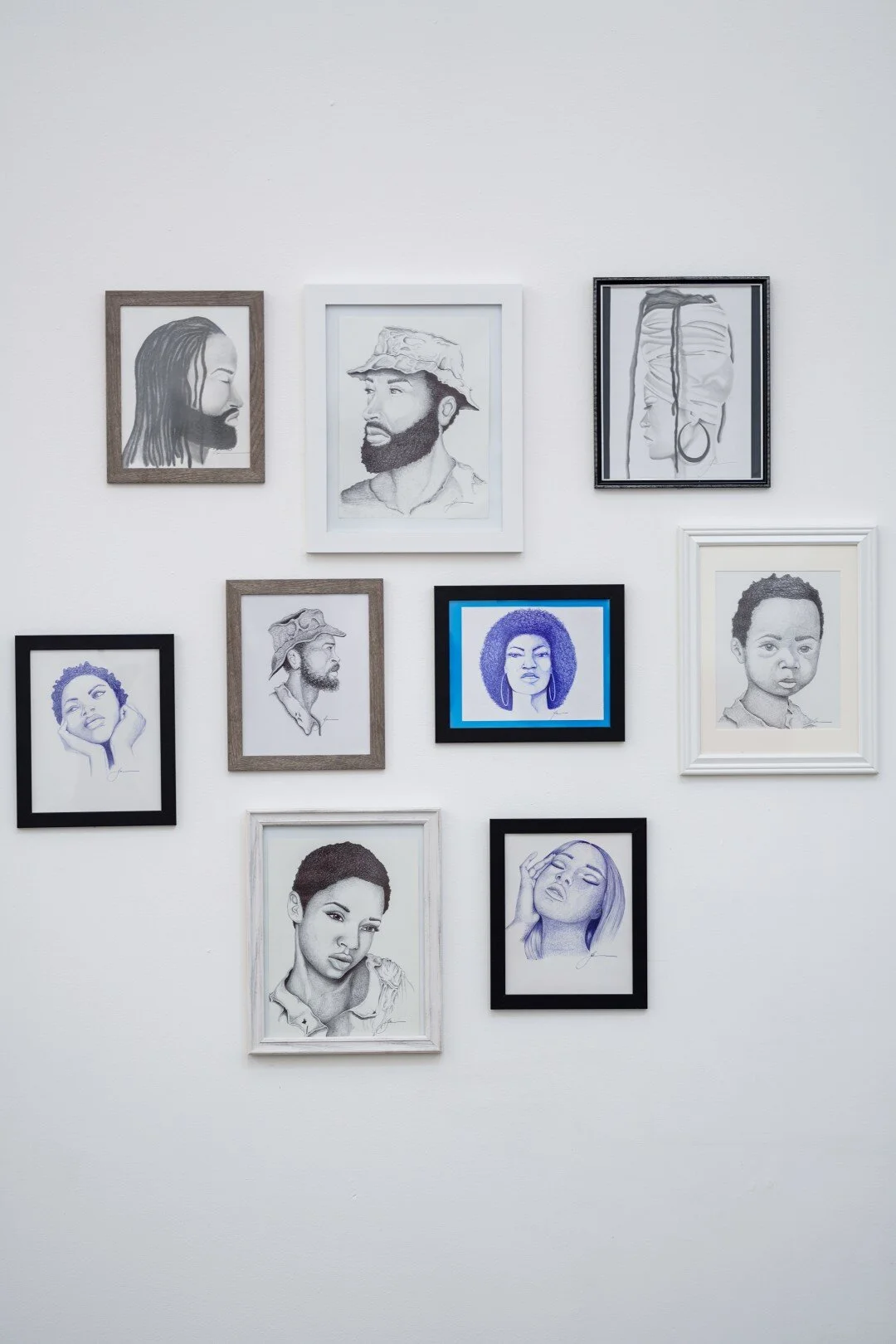“Being part of the show feels “powerful,” Perry said.
”That’s the goal of the show,” Johansen said. “Giving artists an opportunity to show their work on a contemporary stage, humanizing their stories through art. There’s an enigma, there’s an energy, there’s this power coming from the canvases and from the drawings,” said Johansen, who has worked in galleries including Philip Martin in L.A. and Gagosian in New York. “It’s imbued with the intensity of their stories.”
Jason Perry is an artist who was incarcerated for 27 years. His work, about the lasting impact of systemic racism on Black people, is being featured in an L.A. exhibition, “Freedom and Vision.”
(Wally Skalij / Los Angeles Times)
December 18, 2020
COVID-19 ripped through California’s oldest prison, San Quentin, after 121 men were transferred from the California Institution for Men in Chino in May. The outbreak became the deadliest in a California prison, leading to more than 2,200 infections and at least 28 deaths.
Graphic artist, comic book creator and self-described illustrative journalist Orlando Smith documented the terror that he and other inmates experienced during the outbreak, which collided with last summer’s uprisings.
outbreak, which collided with last summer’s uprisings. Smith, 54, has been incarcerated more than 20 years, serving a 241-years-to-life sentence after a jury found him guilty of eight counts of second-degree robbery. During the pandemic lockdowns, inmates could not leave their cells, were fed boxed meals for weeks and showered once every few days.
In one graphic illustration, Smith depicts himself clutching his face after cleaning chemicals — sprayed by a crew covered head to toe in protective gear — get into his eyes and mouth. The incident left him with headaches and blurry vision for days, he said. According to California’s statement on San Quentin’s COVID-19 response, the prison contracted a vendor for a one-time deep clean, which included “electrostatic spraying of unoccupied cells.”
Smith’s work is part of an L.A. exhibition exploring the impact of COVID-19 on artists who have experienced incarceration. It’s the inaugural exhibition of Huma House, a contemporary art initiative created by Meetra Johansen, who hopes to one day turn the venture into a cultural center dedicated to social justice issues. The exhibition was made in partnership with the Bail Project, a national nonprofit offering free bail assistance for indigent defendants.
“Freedom and Vision: A Group Exhibition of Artwork From Inside and Outside the Prison Gates” features work from nine artists, six of whom are incarcerated, including Kenneth Webb, whose paintings reflect on his confinement inside a state prison in Lancaster during the pandemic. Three artists in the show are formerly incarcerated, including Michele Molina, whose “Holy Fire Fury” piece pays homage to incarcerated firefighters working during the pandemic.
The exhibition is on view in-person until Tuesday and virtually until Dec. 27. “There’s an enigma, there’s an energy, there’s this power coming from the canvases and from the drawings,” said Johansen, who has worked in galleries including Philip Martin in L.A. and Gagosian in New York. “It’s imbued with the intensity of their stories.
”The spark for the exhibition began in February. Johansen was interviewing for a position teaching college prep classes at San Quentin when the pandemic put an abrupt hold on the volunteer program.
Still searching for ways to interact with incarcerated men and women, Johansen began digging through a pen pal website — WriteAPrisoner.com — where she stumbled on over a hundred pages of art made in prisons across the country.
“I started to see artworks by these artists who are currently incarcerated, and I’m like, ‘If this is in a gallery, I could easily see someone collecting this work, or I can easily see this in a museum,’” she said. “I felt that the institution of contemporary art wasn’t really opening their doors to that”
She first reached out to a painter and musician in the Michigan Department of Corrections who goes by Banjo Percy. One of Percy’s paintings in the exhibition is “Socially Loving,” which addresses the issues that have “driven us to the peak of our passions including social injustice, loss of loved ones, fear of infection, trying to survive and the overwhelming desire to be heard,” the artist wrote in a statement to Johansen.
Over six months, Johansen continued reaching out to artists, searching for work “that had an undercurrent of something symbolic and that if someone was standing in front of it, they would want to ask more about it.”
One immediate challenge was earning the artists’ trust.
“A lot of these men and women have been taken advantage of in the past,” Johansen said. “People solicit artwork and then they never see it again, or they make promises that they don’t keep.”
Johansen worked with artists’ support systems on the outside to gather work for the show. She received Percy’s pieces from his wife. Webb’s art was collected from two friends — one a former cellmate who helps to manage his inventory of art.
Works in the show range from $500 to $5,000, with 80% of proceeds going to the artists and 20% used for the hard costs of installation.
Johansen could face skepticism from those who argue that incarceration should be punitive and those who might question whether inmates should make money from art while serving time. But supporters of such programs say that across the country, people in prisons face overcrowding, poor healthcare and meager wages. In California, many inmates are required to work — their jobs range from cooking and cleaning to fighting fires to making hand sanitizer and face masks — with wages ranging from 8 cents to $1 an hour.
Prison labor is the only source of income in a system that charges a premium to keep in contact with family and to acquire basic items such as soap and food.
Once released, art making also can help the formerly incarcerated make ends meet on the arduous path toward reintegration into society.
It’s also a form of rehabilitation, potentially beneficial to incarcerated communities and society at large given the high costs of maintaining the criminal justice system. In 2018-2019, the average cost of incarcerating someone in prison was more than $81,000 a year in California.
One compilation of evidence-based studies examining the impact of arts programs in U.S. correctional settings lists benefits including cost savings, increased self-esteem and self-discipline, and the confidence to pursue other academic and vocational opportunities.
The Actors’ Gang offers theatrical arts training in 13 California prisons, and more than 1,000 people have participated. One study found an 89% decrease in disciplinary incidents for those who completed the program. Another preliminary analysis from the California Department of Corrections and Rehabilitation found a 10.6% recidivism rate for people who completed the program. By contrast, according to a 2014 report, about 75% of all inmates released from state prisons are rearrested within five years.
This year, art-making has been limited inside prisons. Before the pandemic, California Arts in Corrections, a partnership between the Department of Corrections and a state agency, the California Arts Council, led and coordinated classes on poetry, dance, drama, music and other forms of art.
But in-person programs have been suspended because of the pandemic, and art making is confined to a cell or dorm.
Prison Arts Collective, a program that partners with California state universities, stopped leading weekly classes in March, instead mailing more than 1,700 distance learning packets to 12 prisons. The group is not allowed to send most types of art supplies, said founder Annie Buckley.
“Most of them don’t have much more than a pencil and maybe some paper,” Buckley added. “So we send in a minimal amount of supplies like colored pencils.”
Johansen was surprised by the level of resilience, creativity and resourcefulness incarcerated artists needed to create. One person she communicated with made art by dying bedsheets with tea, crushing a color pencil into floor wax for pigment and using a plastic spoon with his own hair as a paintbrush. Buckley has met artists who made intricate origami or used dirt collected from the yard for their work.
“It’s not like they can have a regular studio practice where you can be alone and really get involved and work for days at a time,” Johansen said.
While incarcerated, Molina saw people make art from toilet paper rolls, drawings on pillowcases and sculptures made from scrap paper. “People are just so amazing when they actually have so much stripped away,” she said.
While honing her craft in prison, Molina was also able to support herself through commissions from staff to make art. Art is what saved her from the depths of depression. Since being released, Molina lives near L.A. and is focused on becoming a full-time artist and hopes one day to create a nonprofit.
Artist Jason Perry said Johansen was surprised by how fast he created pieces for the show. Working fast was something he learned while incarcerated for 27 years, where he said officers often confiscated or destroyed prisoners’ art.
Perry’s work in the exhibition include ink portraits of Black people, spanning from slavery to present day, serving as commentary on the lasting effects of systemic racism. After being released about a year ago, Perry, 48, lives in Riverside and is focused on working and making art.
Being part of the show feels “powerful,” Perry said.
“There’s so much untapped potential in there, and it’s hard to get away from the stigma of being incarcerated or formerly incarcerated,” he continued. “We have so much to offer and people just have to take a chance. … We just need a platform where we can be accepted.”
That’s the goal of the show, Johansen said. Giving artists an opportunity to show their work on a contemporary stage, humanizing their stories through art.
She gave an example: Numerous outlets reported on the summer outbreak at San Quentin, “but then you see Orlando’s work and it’s like, ‘Whoa there’s a heartbeat, there’s a human in there experiencing these things.’”
Johansen said. Giving artists an opportunity to show their work on a contemporary stage, humanizing their stories through art.
She gave an example: Numerous outlets reported on the summer outbreak at San Quentin, “but then you see Orlando’s work and it’s like, ‘Whoa there’s a heartbeat, there’s a human in there experiencing these things’”
21 Arrows at Huma House
Born in Iran, Omid Mokri studied at the prestigious Honarestan-e Honarha-ye Ziba art school in Tehran and later attended RISD and Cal Arts. Most of the works in Mokri’s 21 Arrows show (open through 13 May) were created during the year he was incarcerated. The artist used pillowcases and sheets as canvases, made his own paint by grinding down the pigments from colored pencils, and fashioned paintbrushes from plastic spoons and his own hair. The act of making this art is undoubtedly art itself. With the intention to humanize those who are dehumanized in the carceral system, the pieces within this show are simultaneously delicate and powerful.
Art Forum lists “Omid Mokri: 21 Arrows” as a Must See.
By RACHEL ZARROW
March 17, 2021
1:07PM
In the 2017 book “How To Do Politics With Art,” Lilian Mathieu describes how the arts play an important role in protest.
“It provides material and symbolic resources,” the French sociologist writes. Art “contributes to movement framing, mobilizes constituencies, sensitizes the broader public, and produces social change by renewing cultural traditions.”
Here are 10 artists who live by that philosophy. Through their work, some of which is currently on display at museums in the Bay Area and across the country, they aim to show the devastating societal toll of mass incarceration and imagine a country without prisons.
On display in Los Angeles
“Art is my home,” says Mokri, a contemporary Iranian artist living in San Francisco.
Mokri became an artist at a young age, studying the works of Iran’s old Persian master painters. After fleeing Iran and moving to the United States during the Islamic Revolution of 1979, Mokri attended the Rhode Island School of Design and California College of the Arts.
Mokri created his most recent work while incarcerated in a California state prison, where he says he had no access to an art space or supplies. Mokri foraged for materials, saving plastic spoons from the cafeteria and attaching his hair to them to create his own paintbrushes. For pigment, he mixed ground-up colored pencils and floor wax, as well as other materials found in the prison yard.
Through his art, he hopes to document the mistreatment and racism he witnessed while incarcerated. His next solo show is at Huma House in Los Angeles, which opens in April.
Omid Mokri solo exhibit: Visual art exhibit. April 10 through May 13. Available in person and virtually by appointment. Huma House. 961 Chung King Road, Los Angeles. www.huma-house.com
“Cogwheel Heart” by Omid Mokri / Photo: Dana Davis,
















